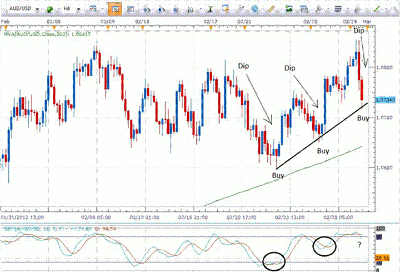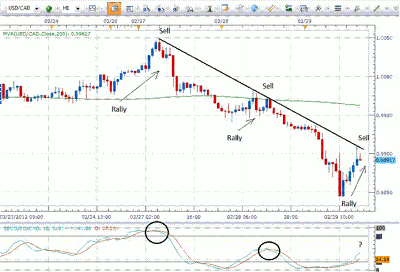Richard Krivo, contributor to DailyFX.com, explains how to buy reversals and sell rallies using recent action in the currency market as a guide.
After a strong countertrend move, as long as the longer-term trend remains intact, looking for opportunities to “buy the dip” and “sell the rally” can be a solid trading strategy.
When identifying a pair that is in an uptrend, the concept of buying the dip can be put to good use. The idea is that as the pair continues to move higher, invariably there will be pullbacks/retracements/dips that occur. When those take place, the trader is presented with an opportunity to enter the trade (buy on a dip) in the direction of the trend at a more favorable price.
Take a look at a current four-hour chart of the AUD/USD below for a visual on this concept:
To time our entry into the trade, an oscillator can be used so we can enter when bearish (downside) momentum shifts to bullish (upside) momentum. In this case, we chose Slow Stochastics. (Note the timing of the entry with the Slow Stochastics crossover to the upside in the circles.)
When buying on dips, a stop can be placed below the lowest candle or wick that occurred during the retracement or dip. In this case, we also have a valid ascending trend line (black line) that can be used for stop placement below the trend line.
In a downtrend, the process would be reversed. Take a look at the current one-hour chart of the USD/CAD below:
To time our entry into this trade, we can enter when bullish (upside) momentum shifts to bearish (downside) momentum. Again, we chose Slow Stochastics. (Note the timing of the entry with the Slow Stochastics crossover to the downside in the circles.)
When selling on rallies, a stop can be placed above the highest candle or wick that occurred during the retracement or rally. In this case, we also have a valid descending trend line (black line) that can be used for stop placement above the trend line.
See also: Forex Strategies: The Breakout Trade
By Richard Krivo of DailyFX.com




















